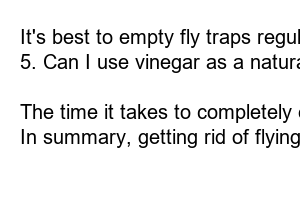날파리 제거방법
How to Get Rid of Flying Flies Easily: A Comprehensive Guide
Are you tired of constantly swatting away those irritating flying flies in your home? We’ve all been there! These little pests can be a real nuisance, but fear not! In this blog post, we will provide you with effective tips and tricks to banish those flying flies once and for all!
1. Identify the Problematic Areas:
First things first, it’s important to determine where these flies are coming from. Check your windows, doors, and any other entry points to see if there are any gaps or cracks that need to be sealed. Potted plants, trash cans, and even fruit bowls can also attract flies, so be sure to inspect these areas as well.
2. Keep Your Home Clean:
Maintaining a clean and tidy living space is crucial in keeping flies away. Vacuuming regularly will help eliminate any crumbs or food particles that may be attracting them. Wipe down surfaces and clean up spills promptly. Remember to dispose of your garbage daily and keep it securely covered.
3. Set Up Fly Traps:
Fly traps are a great way to catch and eliminate flies in your home. You can purchase ready-made traps or make your own using a jar filled with a mixture of sweet liquid like honey or fruit juice. Punch a few small holes in the jar’s lid and place it in fly-prone areas. Flies will be attracted to the scent and will get trapped inside.
4. Natural Repellents:
To deter flies from entering your home, natural repellents can be quite effective. Lemon and cloves are known for their strong scent that flies dislike. Simply slice a lemon and stud it with cloves, then place it in fly-infested areas. You can also create a homemade spray using essential oils such as lemongrass, eucalyptus, or peppermint mixed with water and a bit of dish soap. Spray it around windows and doors to repel flies.
5. Fly Swatters and Zappers:
For those flies that manage to slip through your preventive measures, a trusty fly swatter or electric fly zapper can come in handy. Swatting flies may not be the most pleasant task, but it can be quite effective. Electric zappers use ultraviolet light to attract flies and then zap them with a low-voltage electric grid.
6. Seek Professional Help:
If you’ve tried various methods but still can’t get rid of those flying flies, it may be time to call in the professionals. Pest control experts have access to more advanced techniques and tools to eliminate the problem. They can help identify the root cause and provide targeted solutions to ensure your home remains fly-free.
FAQs
1. Can flies transmit diseases?
Yes, flies are known to carry and transmit various diseases such as cholera, dysentery, and salmonella. That’s why it’s important to keep them out of your living spaces.
2. Are fly traps safe to use around pets and children?
Most fly traps are safe to use around pets and children, but it’s always a good idea to keep them out of reach. Read the product instructions carefully to ensure proper usage.
3. Will fly repellents work outdoors as well?
Fly repellents can be effective both indoors and outdoors. However, keep in mind that outdoor areas may require a larger quantity of repellent to cover a wider space.
4. How often should I empty the fly traps?
It’s best to empty fly traps regularly to prevent them from getting too full and becoming less effective. Check them at least once a week and dispose of the trapped flies in a sealed bag.
5. Can I use vinegar as a natural fly repellent?
Vinegar can be an effective fly repellent due to its strong smell. Dilute white vinegar with water and spray it around your windows and doors to deter flies.
6. How long does it usually take to get rid of flies?
The time it takes to completely eliminate flies can vary depending on the size of the infestation and the methods used. With consistent efforts, you should start noticing a reduction in fly activity within a few days.
In summary, getting rid of flying flies involves identifying problematic areas, maintaining cleanliness, setting up traps, using natural repellents, and employing physical methods like swatters or zappers. If all else fails, don’t hesitate to seek professional help. Remember, a clean and fly-free home is just a few steps away!

